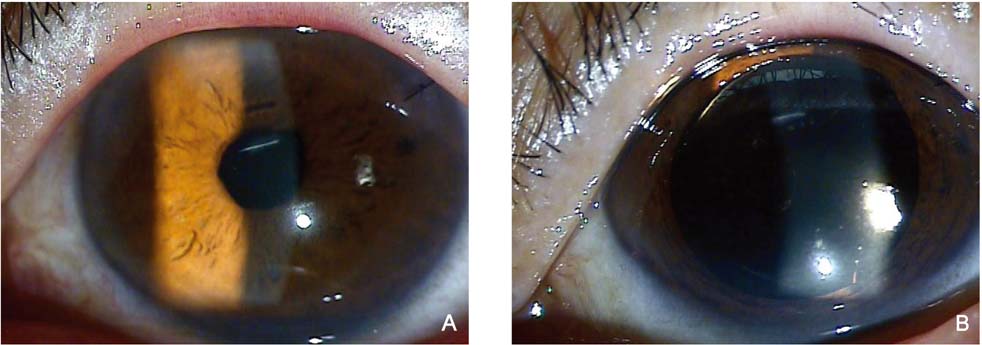Korean J Ophthalmol.
2008 Dec;22(4):272-275. 10.3341/kjo.2008.22.4.272.
A Case of an Asymptomatic Intralenticular Foreign Body
- Affiliations
-
- 1Department of Ophthalmology, College of Medicine, Konyang University, Myung Gok Eye Research Institute, Daejeon, Korea. kopupil@hanmail.net
- KMID: 1084218
- DOI: http://doi.org/10.3341/kjo.2008.22.4.272
Abstract
- The purpose of this article is to report a case of an asymptomatic intralenticular metallic foreign body that was retained for 6 months. A 66-year-old male visited our ophthalmology department because of decreased visual acuity in his left eye 6 months after he suffered ocular trauma while mowing. He had not been treated because he did not experience any discomfort. His corrected visual acuity was 0.4. Central corneal opacity, an intralenticular metallic foreign body, and an intact posterior capsule were observed on slit lamp examination. Phacoemulsification with posterior chamber lens implantation and simultaneous removal of the intralenticular foreign body was performed. Seventeen days after the operation, his corrected visual acuity was 1.0, the intraocular lens was well-seated, and there was no intraocular inflammation. In this case report, a patient was found to have an intralenticular metallic foreign body retained for 6 months. During this time he did not experience any ocular dysfunction due to the foreign body. Mowing accidents are common in Korea. Despite the absence of symptoms, patients reporting a history of lawn mowing should be thoroughly examined.
MeSH Terms
Figure
Cited by 1 articles
-
Endophthalmitis after Removal of an Intralenticular Foreign Body in Place without Symptoms for 20 Years
Young Choi, Youngsub Eom, Soo Youn Choi, Bo Young Lee, Eun Jee Kim, Su-Yeon Kang, Jong Suk Song, Hyo Myung Kim
J Korean Ophthalmol Soc. 2019;60(5):480-485. doi: 10.3341/jkos.2019.60.5.480.
Reference
-
1. Williams DF, Mieler WF, Abrams GW, Lewis H. Results and prognostic factors in penetrating ocular injuries with retained intraocular foreign bodies. Ophthalmology. 1988. 95:911–916.2. Ahn M. Noninfectious endophthalmitis caused by an intraocular foreign body retained for 16 years. J Korean Ophthalmol Soc. 2001. 42:793–796.3. Lin HC, Wang HZ, Lai YH. Occult plastic intravitreal foreign body retained for 30 years: a case report. Kaohsiung J Med Sci. 2006. 22:529–533.4. Kwak DH, Park JM, Song JK. Clinical analysis of ocular injuries induced by power lawn mowers. J Korean Ophthalmol Soc. 1996. 37:1309–1314.5. Kee HS, Kim SJ, Seo MS. Intraocular foreign bodies by power lawn mowers. J Korean Ophthalmol Soc. 1995. 36:1827–1832.6. Staples BA, Potgieter F, Duyvené de Wit LJ, de Bruyn H. Lenticular chalcosis-electron microscopic and microprobe analysis. A case report. S Afr Med J. 1992. 81:274–276.7. Seland JH. The nature of capsular inclusions in lenticular chalcosis. Report of a case. Acta Ophthalmol (Copenh). 1976. 54:99–108.8. De Juan E Jr, Stenberg P Jr, Michels RG. Penetrating ocular injuries. Types of injuries and visual results. Ophthalmology. 1983. 90:1318–1322.9. Arora R, Sanga L, Kumar M, Taneja M. Intralenticular foreign bodies: report of eight cases and review of management. Indian J Ophthalmol. 2000. 48:119–122.10. Cazabon S, Dabbs TR. Intralenticular metallic foreign body. J Cataract Refract Surg. 2002. 28:2233–2234.11. Dhawahir-Scala FE, Kamal A. Intralenticular foreign body: a D-Day reminder. Clin Experiment Ophthalmol. 2005. 33:659–660.12. Coleman DJ, Lucas BC, Rondeau MJ, Chang S. Management of intraocular foreign body. Ophthalmology. 1987. 94:1647–1653.13. Keeney AH. Intralenticular foreign bodies. Arch Ophthalmol. 1971. 86:499–501.14. Pieramici DJ, Capone AJ, Rubsamen PE, Roseman RL. Lens preservation after intraocular foreign body injuries. Ophthalmology. 1996. 103:1563–1567.15. Griffiths ML, Lee GA. Retained intraocular foreign body. Clin Exp Optom. 2004. 87:34–36.16. Lee WJ, Park SY, Park TK, et al. Mature cataract and lens-induced glaucoma associated with an asymptomatic intralenticular foreign body. J Cataract Refract Surg. 2007. 33:550–552.17. Hwang YH, Kim DS, Monn SW, Lee DY. Lens particle glaucoma with intralenticular foreign body. J Korean Ophthalmol Soc. 2007. 48:1723–1727.18. Wiedenthal DT, Schepens CL. Peripheral fundus changes associated with ocular contusion. Am J Ophthal. 1966. 62:465–477.19. Fagerholm PP, Philipson BT. Human traumatic cataract. A quantitative microradiographic and electron microscopic study. Acta Ophthalmol (Copenh). 1979. 57:20–32.20. Seland JH. Production of human lens capsule illustrated by a case of chronic lenticular chalcosis. Acta Ophthalmol (Copenh). 1976. 54:301–310.21. Lee LR, Briner AM. Intralenticular metallic foreign body. Aust N Z J Ophthalmol. 1996. 24:361–363.22. Luo Y, Wang Z, Lin X, Hu S. Removal of intralenticular magnetic foreign bodies with intraocular magnet. Yan Ke Xue Bao. 2003. 19:142–145.23. Macken PL, Boyd SR, Feldman F, et al. Intralenticular foreign bodies: case reposts and surgical review. Ophthalmic Surg. 1995. 26:250–252.24. Mach R, Procházková L, Susický P. Intralenticular metal foreign bodies. Cesk Slov Oftalmol. 2001. 57:38–42.25. Wang Z, Shi Y. The treatment of lenticular magnetic foreign body using tri-combined operation. Yan Ke Xue Bao. 1994. 10:105–107.26. Pieramici DJ, Capone AJ, Rubsamen PE, Roseman RL. Lens preservation after intraocular foreign body injuries. Ophthalmology. 1996. 103:1563–1567.
- Full Text Links
- Actions
-
Cited
- CITED
-
- Close
- Share
- Similar articles
-
- Endophthalmitis after Removal of an Intralenticular Foreign Body in Place without Symptoms for 20 Years
- Long-standing Asymptomatic Intralenticular Foreign Body
- A Case of Foreign Body Granuloma after Squalene Injection by Non-dermatologists
- A Case of Intralenticular Triamcinolone Complicated by Intravitreal Triamcinolone Acetonide Injection
- Long-Standing Blades of Scissors in Paranasal Sinus Over 40 Years




